As the capital and largest city in Portugal, Lisbon is the perfect place for solo travel wandering to find a comprehensive sample of Portuguese culture. The streets of Lisbon are famously beautiful, but the city’s notoriety as a picturesque and cheap destination also brings millions of tourists annually.
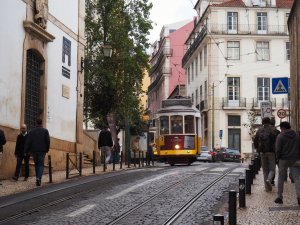
This guide will help you check off all the top attractions in Lisbon, but it will also help curious travelers see more of the city. Solo travel is the best way to explore Lisbon, but there is still plenty to see and do when traveling with others.
Highlights of Lisbon
The real highlight of travel in Lisbon is the city itself. Lisbon doesn’t have a single, iconic landmark that attracts tourists. Aside from the century-old, bright yellow trams climbing the hills, there is not a stationary landmark which people associate with the city.
In many ways, the broad attraction of Lisbon is a bonus for travelers. Rather than clamoring their way to the front of the line for a single landmark, tourists in Lisbon come to experience more. Freely wandering the narrow, hilly streets is the best way to experience the city, and that is what makes solo travel in Lisbon the best way to explore this city.
Despite lacking a single point of interest, there are plenty of specific attractions to check out in Lisbon. And there are some to be skipped, too. These are a few of the most popular (and a few of my favorite) things to see and do in Lisbon:
Castelo de Sao Jorge
If there is a single, immobile attraction that draws the most attention, it would be the fortress of Lisbon, Castelo de Sao Jorge. This medieval hilltop castle is one of the main tourist attractions in all of Portugal and is visible from across the city (provided there aren’t any hills obstructing the view).
Castelo de Sao Jorge, ‘Saint George Castle’ in English, is more impressive from afar than it is up close. The medieval walls have a powerful appearance, but there isn’t much to see within the complex itself.
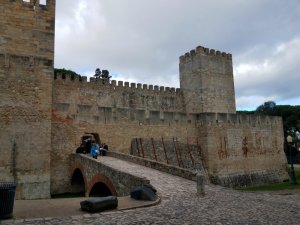
The Sao Jorge hilltop complex consists of a large courtyard, a museum, a cafe, ruins of a palace, more ruins and, of course, the castle. Oh, and there are several peacocks roaming about. The outer walls, fortress walls and towers are notably well-preserved/renovated, but that’s about it.
The best part of visiting Castelo de Sao Jorge is the view. The walls and towers of the fortress provide excellent views across Lisbon. The courtyard area has nice views of the Tagus River estuary, and it’s a nice area to find a bench and appreciate a shaded view of Lisbon.
Historically, Castelo de Sao Jorge is incredibly important. For practical purposes of visiting, however, it leaves a lot to be desired. Traveling to Lisbon and skipping the castle isn’t sacrificing much. The view may be good, but the €10 admission can be better spent elsewhere.
Belem Tower
The Belem Tower is another famous landmark of Lisbon. The 500-year-old tower is historically significant as the ceremonial launching point for many Portuguese explorations. The 100-foot-tall structure is pretty, but that’s where the positives of Belem Tower end.
Lisbon’s famous Belem Tower is another unimpressive attraction in Lisbon. It might be nice to explore if there weren’t so many people, but the tower is full of tourists and not very large. Even as a solo traveler in Lisbon, there is no way to effectively navigate and avoid the crowds.
To make the prospect of visiting Belem Tower even more bleak, it’s out of the way for tourists. Walking to the tower is a dull hour-and-a-half trek, and even public transportation takes a solid 30 minutes.
As it is, Belem Tower is essentially a dressed-up stack of old bricks. Wasting time in line to spend €6 in a small, crowded tower is not worth the effort. Solo travel in Lisbon is better spent getting lost in the old, pretty neighborhoods.
Santa Justa Lift
The Santa Justa Lift, or Elevador de Santa Justa, is just that – it’s an elevator. It’s certainly one of the prettiest elevators I’ve ever seen, but why would you ever want to waste time standing in line and then pay to go up an elevator?
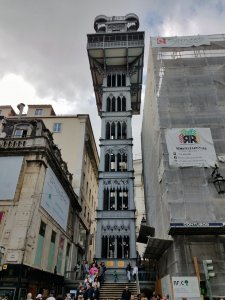
The purpose of the Santa Justa Lift is another combatant to the terrain of Lisbon. Today, it is little more than a tourist attraction. Although Castelo de Sao Jorge leaves a lot to be desired, at least it offers more than a view. Lisbon’s famous elevator, on the other hand, is a total waste of time. There are far too many free hilltop views without the need to stand in a line.
Get Lost in Alfama
Alfama is the oldest and most famous neighborhood of Lisbon. The neighborhood is home to many of Lisbon’s notable attractions. The most attractive feature of Lisbon is the city itself, and nowhere is this more evident than Alfama.
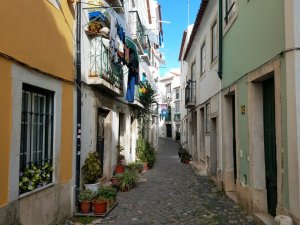
Many of the famous, identifiable scenes of Lisbon are, in fact, scenes of Alfama. This is certainly the most photogenic portion of the city, and, at times, there are crowds and tour groups to prove it. But Alfama is also one of the best places to explore for solo travel in Lisbon.
Despite the popularity and crowds in Alfama, it is surprisingly easy to get lost and find yourself alone on a quiet street. The neighborhood isn’t particularly expansive, but the wild conglomeration and mish-mash of streets means it’s easy to escape the masses of tourists. And the hilly terrain provides even more nooks and crannies to explore.
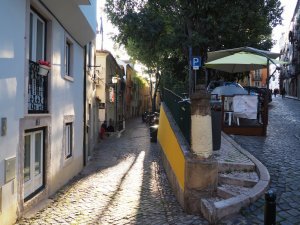
The primary drawback to Alfama is the tour groups. Like I said, it is easy to escape the crowds for more peaceful scenes, but any sense of charm or quaintness disappears when a tour group comes rolling through. These experiences strengthen my belief that solo travel is the best way to see Lisbon. The freedom of wandering alone allows you to take the time to get lost and thoroughly probe into the labyrinth of Alfama.
The Lisbon Tram
The Lisbon Tram is, today, the most iconic tourist landmark in the city. Photos of the yellow trams squeezing through the narrow streets of Lisbon have drawn a lot of attention in recent years. The trams are undoubtedly a photogenic feature of the city, and whomever is in charge of marketing tourism in Lisbon has done well promoting the scene.
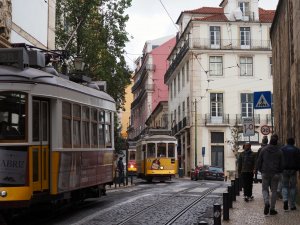
The origin of trams in Lisbon goes back to the 1800s. Today, they are largely for the benefit of tourists. The Lisbon Metro is a better choice for most locals and anyone that wants to see parts of the city far from the tourist areas.
Tram line 28 is the most famous line. Line 28 is the one that always seems to be packed full of tourists. It runs up the hills of Alfama, depositing tourists at famous stops, and modeling for photos along the way. Tram 28 is also a great way to expand your travel boundaries in Lisbon. It doesn’t traverse the city to the same extent as the metro, but it is a great way to see a large chunk of Lisbon easily, cheaply (€3) and comfortably.

Lisbon’s trams are attractive and practical. The city’s hills are a nuisance at times, and the tram is an easy way to ascend (almost) to the tops with ease. Although my preferred method of solo travel is almost always walking, riding the trams in Lisbon is kinda fun.
Mercado de Santa Clara
Shopping is not my favorite way to spend time. In fact, this is generally a thoroughly effective way to put me in a sour mood. Backpacking is different, though, especially in countries with interesting (and often tumultuous) histories. Flea markets often have a lot of peculiar stuff from these countries’ storied histories.
For me, as a novitiate numismatist, Portuguese history means interesting coins at flea markets – that is, coins of countries and colonies that no longer exist.

I thoroughly enjoy flea markets. One of the best things about solo travel in Lisbon is wandering through Mercado de Santa Clara. I don’t draw much attention by myself, and I feel like haggling is easier when alone.

In the shadow of Panteao Nacional (National Pantheon, a large church), Mercado de Santa Clara is a disorganized flea market in Lisbon. Like most flea markets, there’s plenty of junk. And there are a lot of head-scratching items, too. Who sells a large sink at a flea market?
For the most part, however, Mercado de Santa Clara is a normal flea market. In addition to all of the junk, there are local artists, clothes and smaller kitchenware, among other usual flea market goods. Flea markets are always fun places to wander, especially in countries away from home. It’s a first-hand look at life’s random things and how they differ around the world.
Mercado de Santa Clara is open two days a week, Tuesdays and Saturdays from 9 AM to 6 PM. The flea market attracts tourists but is still a local event.
Carmo Convent
It doesn’t take long in Lisbon to hear references to the massive and devastating earthquake of 1755. The earthquake caused fires, tsunamis and tens of thousands of deaths. Almost all of Lisbon was destroyed, including many famous landmarks. The rebuilding of Lisbon changed the appearance of the city, with wider streets and new, earthquake-resistant architecture.
Very little surface evidence remains of the 1755 Lisbon earthquake. The exception to that is the ruined church of Carmo Convent.
The remains of the Carmo Convent church look like a victim of modern-day bombing. The roof is gone, and all that remains are the walls and the pillars. The ruins are an interesting site to see, and when not too busy, the scene is a little eerie. Although a frightening reminder of the power and impending destruction of an earthquake, the convent is a cool place to visit and even has a decent view.
The Best Views in Lisbon
The hills of Lisbon provide more than winded travelers. They lead to viewpoints. Each viewpoint is unique, and finding unexpected viewpoints are a benefit of solo travel in Lisbon. As I climbed the hills in no particular direction, random plazas, parks and gaps in buildings appeared with excellent views of the surrounding city.
Castelo de Sao Jorge
The best part of visiting Castelo de Sao Jorge is the view. The views from the fortress walls are some of the best in Lisbon. Visitors can look down upon the neighborhood of Alfama, the estuary of the Tagus river and across the river mouth to the city of Almada.

The drawback to the view at Castelo de Sao Jorge is that it costs €10 for entrance to the fortress. If you visit in the evening, and during the right season, the castle is an excellent place to watch the sunset in Lisbon. I cannot, however, in the spirit of backpacking, suggest that this view is worth €10.
Miradouro das Portas do Sol
This viewpoint is part of a popular little plaza in Alfama. It looks and functions as a sort of public observation deck, but there are also locals playing music and selling art (good luck trying to buy something).
Miradouro das Portas do Sol is free and has decent views of the surrounding neighborhood. This is a good spot to take a few minutes to catch your breath while wandering the hills of Alfama.
Miradouro de Santa Luzia
Miradouro de Santa Luzia is a short walk from Portas do Sol. Santa Luzia, though, is a little more comfortable. This viewpoint is attached to a small garden, and the ledge is ideal for taking a seat to really soak in the view.
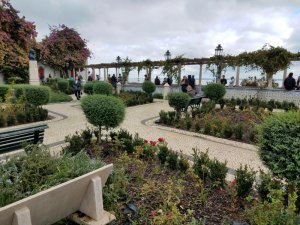
Miradouro de Santa Luzia is one of my favorite viewpoints in Lisbon. It’s free, the surrounding garden is pleasant and the view is great. It can get a little crowded, though.
Miradouro da Graca
Miradouro da Graca has a nice panoramic view of Lisbon. The viewpoint is an excellent place to catch a sunset and has great views of the city center below. Miradouro da Graca also has the best views of the castle, especially when it shines at night.
Santa Justa Lift
Another paid view is found at the top of Elevador de Santa Justa. The unique view comes with a price tag and long lines. It’s a waste of time. There are comparable views nearby that are free, or, at the very least, cheaper. Find any nearby hill or balcony and there are equally impressive views.
Miradouro da Senhora do Monte
Miradouro da Senhora do Monte is probably the best viewpoint in Lisbon. It has panorama views across the city, including the fortress hill and even out to the Tagus River.
Miradouro da Senhora do Monte is usually not too busy, but crowds may gather around sunset in the high season. It is just out of the way enough to be off of most tourist radars.
Get Lost – Solo Travel Wandering in Lisbon
It’s easy to get off the tourist trail when you travel solo in Lisbon. Per usual, this is an exceedingly difficult thing to do if you’re traveling in a group. If you’re backpacking, traveling alone or if you have any free time outside of a strict group schedule, it’s easy to escape the tourist crowds without wandering all the way to the outskirts of the city.
Here are some of my favorite spots in Lisbon to wander off and enjoy a local, less touristy side of the city:
Jardim da Estrela
Estrela Garden, Jardim da Estrela, is a fascinating park in the Estrela neighborhood. The neighborhood is close to popular tourist areas but far enough away that not many visitors are willing to make the 20-minute walk.
Jardim da Estrela is like the empire park of Portugal. It is a small park full of plants (and even a few birds) that are native to parts of the once-extensive Portuguese empire. It’s like walking through an exhibition of Portuguese natural history, with trees, flowers and plants that are wholly out of place. The various species hail from India, South America, Africa and the Far East.

If you’re willing to make the walk – or simply take a tram that stops right in front of the park – there is a stunning cathedral directly across the street.
Junta de Freguesia de Campo de Ourique
Junta de Freguesia de Campo de Ourique is a neighborhood co-op, a kind of community center. While most neighborhoods/districts of Lisbon have some kind of official community center, this one in Campo de Ourique stands out.
Junta de Freguesia de Campo de Ourique is more than the home of neighborhood meetings, choir practice and crafting classes. It is a popular local hangout. Residents of the neighborhood, both young and old, gather here to socialize, eat and drink.
For travelers in Lisbon hoping to find a touch of authenticity among the tourist facade, there is no place better than this neighborhood co-op. Junta de Freguesia de Campo de Ourique is not like the community centers or co-ops with which I am familiar (in the United States). For one, they’re is a fully functional bar and restaurant. It doesn’t seem to be shrouded in politics (though I do not read or speak Portuguese), and people actually frequent the place. To me, it seems like a cool place to hang out.
Visiting Junta de Freguesia de Campo de Ourique is best as a solo travel experience in Lisbon. Personally, I wouldn’t want to encroach on their local scene with more than one or two outsiders. It is not, however, a private space, and the building is open to the public.
Neighborhoods
There are a few neighborhoods near the tourist center of Lisbon which are primarily local and infrequently visited by tourists. The following neighborhoods are great for solo travel wanderings in Lisbon to get off the beaten path without straying too far:
- Campo de Ourique – “newer” central neighborhood, great to wander with fantastic food everywhere
- Santo Antonio – near tourist center and many hotels, but there are plenty of alluring side streets
- Estrela – hilly, winding and photogenic streets with old buildings, almost like Alfama without the tourists
- Anywhere – Lisbon is a beautiful, safe city. Wandering in any direction is sure to lead to pretty buildings, local life and good food.
Eating & Drinking in Lisbon
Lisbon has an interesting culinary scene. The Portuguese empire that once had possessions in South America, Africa, India and China brought a tremendous variety of flavors back to Lisbon. These various spices, plants and cooking styles are evident in modern Portuguese cuisine.

For a thorough rundown of what and where to eat in Lisbon, check out the Hangry Backpacker’s guide to eating and drinking in Lisbon.
Other Tips for Visiting Lisbon
English is Everywhere
Don’t worry about being fluent in Portuguese. Surprisingly, English is widely spoken in Lisbon. Coming from Spain, where I was equally surprised (and pleased, personally) at how little English is spoken, it’s odd to find a place where it seems like almost everyone speaks English.
For better or worse, Portugal’s economy is highly dependent on tourism. The result is that many people in Lisbon, Porto and other popular tourist destinations in the country have a high proficiency in English.
On one hand, as a native English speaker, it makes travel easier in Portugal. On the other hand, I don’t travel to foreign countries to speak my own language. However, hearing English spoken helps in determining whether or not a place/area is touristy.
Not everyone in Portugal speaks English. Younger people tend to be more fluent. Otherwise, it largely depends on the sector in which the individual works. Those who interact with tourists are more likely to have a working knowledge of English.
As always when traveling, it’s good to know a few basic phrases. Portuguese and Spanish share words, but they are not the same. Although I picked up a few extra words, basic words like yes/no (sim/nao), thank you (obrigado/a), hello (ola) and beer (cerveja) were enough for me.
Watch Your Step
The worst part about Lisbon is the sidewalks. These damn sidewalks are a hazard (at least for me). I’ve had better traction on a slip n’ slide.
The sidewalks of Lisbon are pretty. Personally, perhaps it’s the practical American in me, I look at Lisbon’s sidewalks and see a serious waste of money and man-hours. Then again, they’re pretty and probably one of those little things most tourists love.
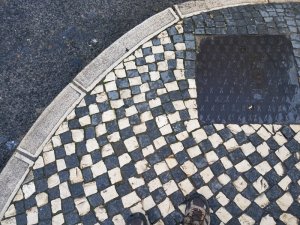
The sidewalks in Lisbon are made of limestone, which is not a tacky surface. Adding in wear and tear from millions of footsteps, the sidewalks in Lisbon are smooth and shiny. When rain enters the equation, the sidewalks in Lisbon are an absolute hazard. The hills only make it worse. Somehow, locals are conditioned to the slick surfaces and have no issues whatsoever, rain or shine.
I’m a large human, and I’m certainly not known for my agility and balance, but walking is what I do when I travel. Lisbon is a joy to walk around when it’s sunny and dry. It’s a different story when it rains. Walk carefully.
The Hills of Lisbon
I’ve alluded to the hills of Lisbon several times already. The terrain of the city is a factor to consider when visiting, especially for solo travel in Lisbon that involves a lot of walking.
Lisbon is hilly. Even when using the trams to combat the city’s hills, walking is inevitable. For travelers averse to hills, it may be best to skip Lisbon. If you can power through the winding inclines of Lisbon, the reward is worth the effort.
The best way to take on the terrain of Lisbon is to let curiosity lead the way. Most of the city is not in a grid layout. The hills of older parts of the city are covered in a cluster of streets, alleys and narrow passages that twist and turn through the neighborhoods. If a particular side street looks enticing, take a detour.
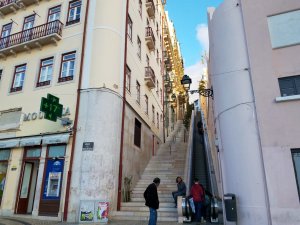
The hills of Lisbon are better enjoyed slowly exploring rather than rushing straight to the top. Travel is not a race. Take your time. Get lost. See More.
I love walking around when I travel. It’s the best way to explore a destination and thoroughly take in the surroundings. Walking up and down hills is not my preference, though. I’m a flatlander by nature. Fortunately, the hills of Lisbon make the city a unique destination and provide visitors with spectacular views and scenes.
Ignore the Drug Dealers
Portugal has infamously liberal laws regarding drug use. Whether or not that is the reason there are so many sketchy people trying to sell drugs is a debate for someone else. As a traveler, it’s annoying.
This may be one of the drawbacks of solo travel in Lisbon, or perhaps it is merely a part of being a backpacker in my 20s. For my part, I can honestly say that more people attempted to sell me drugs in Lisbon than anywhere else in the world. And that includes American music festivals!
The drug dealers in Lisbon are brazen, to say the least. They sell everything from weed to heroin. The good news is, however, that they are generally harmless and easy to deal with (no pun intended).
Most of the drug peddlers in Lisbon will leave you alone if you decline or ignore them. If you appear interested at all, perhaps even if you’re merely caught off guard, they may offer a time or two more and attempt to talk to you. Keep walking. These sketchy dudes aren’t going to waste their time on most people.
If, for some idiotic reason, you decide that enhancing your travels sound like fun, know that you’re making a mistake. A backpacker at my hostel in Porto bought a bag of weed off the street. He was really pissed when his €20 got him a bag of green cooking herbs.
I don’t understand the allure of drugs abroad. If you want to do something stupid, do so in the comfort of your own home home. Or go to Amsterdam! As a general rule in the tourist areas of Lisbon, ignore anyone that approaches you.
Getting Around – Transportation in Lisbon
Getting around Lisbon is easy enough. Everything is pretty straightforward. From a safety standpoint, Lisbon is quite safe for pedestrians and safe for individuals roaming at night (who practice normal caution).
Walking/Biking
Walking is an adequate way for most tourists to travel around Lisbon. In the touristy areas, everything is close together. Travelers of average fitness can walk to most of the popular landmarks in Lisbon with relative ease. The only real challenges are the hills and slippery Lisbon sidewalks.
Lisbon is not a bike-friendly city, at least not for tourists. I don’t recall seeing a single bike lane in the older, touristy part of the city. And even if there are bike lanes, the terrain would make bicycling a less-than-pleasant experience.
The Famous Lisbon Tram
I’m pretty sure the famous Lisbon tram is only there for tourists. It’s photogenic, iconic and, especially today, an important feature of Lisbon. Examining the routes, it seems to be the case even more so. Aside from helping lazy tourists or physically disabled persons, the tram is useless.

The Lisbon tram can take tourists to Belem, Estrela, Ourique and up the steep hills of the city’s old neighborhoods such as Alfama. Otherwise, there is little need to use the tram, but it’s a fun way to see the city if you find a relatively empty car. Most of the time, the tram is crowded with long lines.
Practical Public Transportation in Lisbon
Lisbon has an extensive metro system. The Lisbon Metro, reaching far into the suburbs and areas where tourists never go, is the practical mode of transport for most locals.
For tourists, the metro is an easy way to reach the various train/bus stations or the airport. The metro also connects to the outskirts of the city and landmarks that are farther from the city center. At €1.50, it’s not as cheap as the subways in other cities, but it is still a cheap and easy way to get around Lisbon.
Air Travel
Lisbon’s airport, Humberto Delgado Airport, is not too far from the city center. It’s easy and cheap to take the metro (Red Line) to your accommodation. For most tourists in Lisbon, take the Red Line and transfer to the Green Line (toward Cais de Sodre) at Alameda station. The next few stops are near most tourist hostels, hotels and guesthouses.
The city bus from the airport is another option but takes considerably longer. Uber is cheap and it takes about 20 minutes (depending on traffic) to reach the city center from Lisbon Airport.
There are tons of cheap flights into Lisbon Airport from across Europe. From North America, it is generally more expensive with a few exceptions. There are regular deals from Toronto, JFK, Boston and a few other larger international airports.
Transport Elsewhere in Portugal
Onward travel (within Portugal) from Lisbon is more complicated. Once you’re on the bus or train, it’s easy, but figuring out the details is slightly more involved. I found the language barrier to be a challenge at many bus/train stations throughout Portugal, but that’s the easy part.
There are several bus and train stations in Lisbon. Which station travelers need to go to depends where the next destination is and what company is going there. There’s no simple answer. Fortunately, Portugal is not very large, and Lisbon is fairly connected to the entire country.
Schedules change often, so the best advice for solo travel in Lisbon is to inquire at the station; or find a schedule online, and arrive at a station considerably early.
Lisbon – The Time to Travel is Now
Lisbon has quickly become a major tourist destination in the last several years. Once an afterthought, the whole of Portugal is now on traveler bucket lists around the world. Images from neighborhoods like Alfama draw the attention of prospective travelers, and the relatively cheap cost of travel in Portugal seals the deal.
Currently, Alfama has plenty of tourist restaurants and souvenir shops. As a whole, the neighborhood has maintained its local identity, and most of the buildings are owned and occupied by locals. In a popular and picturesque setting like this, it’s only a matter of time before the entire area is commercialized and loses its local appeal.
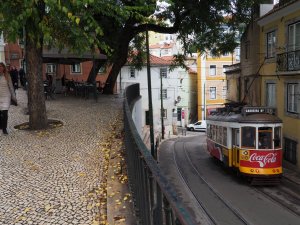
On the one hand, it will be great for local residents to see a payday. Conversely, the very reason tourists are attracted to Alfama – the overall charm and attraction of Lisbon, in general – will dissipate with these changes.
The perfect example is a short walk away. The entire area (and more), from Santa Justa elevator to the river, sucks. It’s completely overrun with souvenir shops, disgustingly overpriced tourist restaurants and selfie-snapping bozos. It’s pretty, but there is no sense of authenticity here.
Eventually, Alfama is likely to follow suit and become another area to fall victim to tourism. In the meantime, a great majority of Lisbon is holding out, and, for now, Alfama remains a cool place to wander. The best thing to do is travel to Portugal and explore the streets of Lisbon as soon as possible.
Leave a Reply
You must be logged in to post a comment.